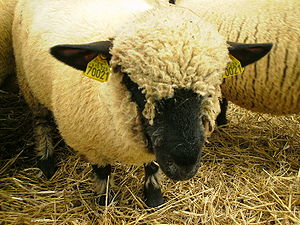m (W126jep moved page Adventist Youth Honors Answer Book/Sheep Breeds/Hampshire to AY Honors/Sheep Breeds/Hampshire without leaving a redirect: Part of translatable page "Adventist Youth Honors Answer Book/Sheep Breeds/Hampshire") |
|||
| (12 intermediate revisions by 4 users not shown) | |||
| Line 1: | Line 1: | ||
| − | + | <noinclude><translate><!--T:1--> | |
| + | </noinclude> | ||
| − | + | <!--T:2--> | |
| − | + | {{ | |
| − | |||
| + | <!--T:3--> | ||
| + | Breed id | ||
| + | |name = Hampshire | ||
| + | |image = Mouton Hampshire.JPG | ||
| + | |description = | ||
| + | The Hampshire is a breed of sheep developed from the Southdowns. | ||
The Southdowns had long had sheep which had dark brown or black legs, matured early, produced the best of mutton and a fine quality of medium wool. The original Hampshire was larger, coarser, but hardier, slower to mature, with inferior flesh, and a longer but coarser wool. The Southdown had always been remarkable for its power of transmitting its special characteristics to its progeny by other kinds of sheep, and hence it soon impressed its own characteristics on its progeny by the Hampshire. The horns of the original breed have disappeared; the face and legs have become dark, the frame has become more compact, the bones smaller, the back broader and straighter, the legs shorter, and the flesh and wool of better quality, while the superior hardiness and greater size, as well as the large head and Roman nose of the old breed, still remain. Hampshires of the 1890s matured early and fattened readily. They clipped from six to seven pounds of wool, suitable for combing, which was longer than Southdown wool, but less fine. | The Southdowns had long had sheep which had dark brown or black legs, matured early, produced the best of mutton and a fine quality of medium wool. The original Hampshire was larger, coarser, but hardier, slower to mature, with inferior flesh, and a longer but coarser wool. The Southdown had always been remarkable for its power of transmitting its special characteristics to its progeny by other kinds of sheep, and hence it soon impressed its own characteristics on its progeny by the Hampshire. The horns of the original breed have disappeared; the face and legs have become dark, the frame has become more compact, the bones smaller, the back broader and straighter, the legs shorter, and the flesh and wool of better quality, while the superior hardiness and greater size, as well as the large head and Roman nose of the old breed, still remain. Hampshires of the 1890s matured early and fattened readily. They clipped from six to seven pounds of wool, suitable for combing, which was longer than Southdown wool, but less fine. | ||
| − | |||
| − | |||
| − | |||
| − | |||
| − | |||
| − | |||
| − | |||
| − | |||
| − | + | <!--T:4--> | |
| − | + | The resultant mutton had a desirable proportion of fat and lean, and was juicy and fine flavored; the lambs were large and were usually dropped early and fed for market. | |
| − | |||
| − | |||
| − | + | <!--T:5--> | |
| − | + | }} | |
| − | |||
| − | |||
| − | |||
| − | + | <!--T:6--> | |
| − | [[Category: | + | [[Category:Adventist Youth Honors Answer Book|{{SUBPAGENAME}}]] |
| + | <noinclude></translate></noinclude> | ||
Latest revision as of 21:37, 8 September 2021
Hampshire
The Hampshire is a breed of sheep developed from the Southdowns. The Southdowns had long had sheep which had dark brown or black legs, matured early, produced the best of mutton and a fine quality of medium wool. The original Hampshire was larger, coarser, but hardier, slower to mature, with inferior flesh, and a longer but coarser wool. The Southdown had always been remarkable for its power of transmitting its special characteristics to its progeny by other kinds of sheep, and hence it soon impressed its own characteristics on its progeny by the Hampshire. The horns of the original breed have disappeared; the face and legs have become dark, the frame has become more compact, the bones smaller, the back broader and straighter, the legs shorter, and the flesh and wool of better quality, while the superior hardiness and greater size, as well as the large head and Roman nose of the old breed, still remain. Hampshires of the 1890s matured early and fattened readily. They clipped from six to seven pounds of wool, suitable for combing, which was longer than Southdown wool, but less fine.
The resultant mutton had a desirable proportion of fat and lean, and was juicy and fine flavored; the lambs were large and were usually dropped early and fed for market.

